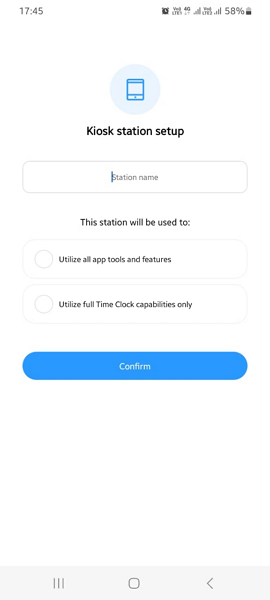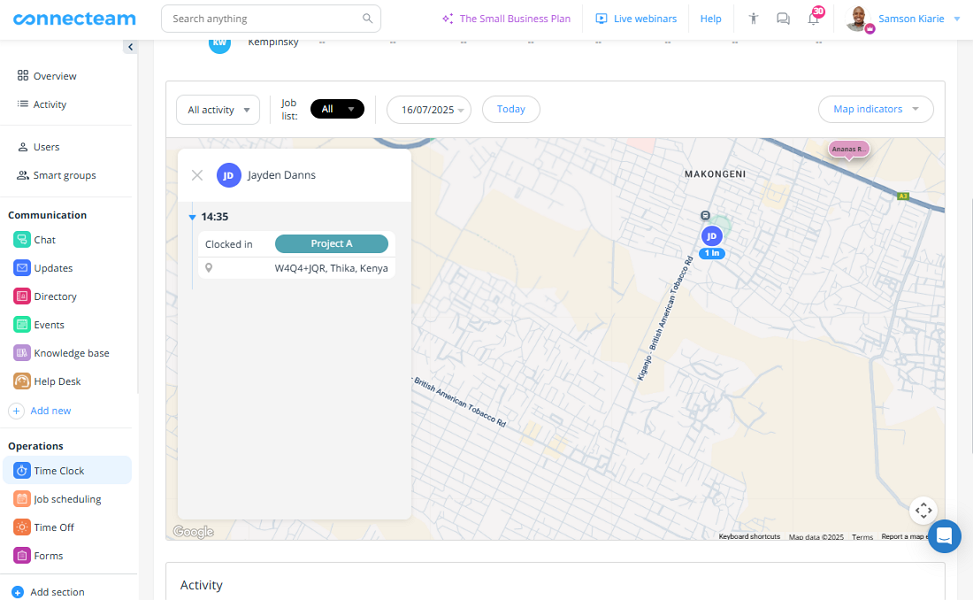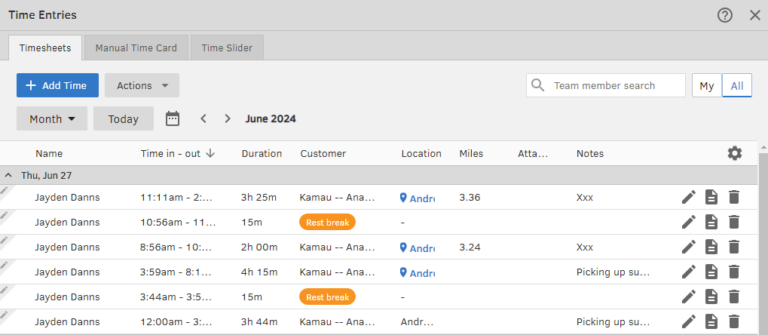Connecteam and QuickBooks Time are both reliable time tracking apps, but Connecteam delivers more value and flexibility for managing deskless teams.
QuickBooks Time focuses on precise time tracking and payroll integration, while Connecteam goes further by combining time tracking with scheduling, GPS, PTO, compliance, and communication in one easy-to-use app.
Choosing between the two isn’t just about tracking hours—it’s about finding the tool that can scale with your business and prevent costly compliance issues.
In this Connecteam vs QuickBooks Time guide, I’ll compare their pricing, features, pros, and cons to help you decide which platform truly fits your workforce.
A note about our method: All product comparisons and verdicts in this guide are based on hands-on testing by our expert team. Every screenshot was taken from real use during our evaluation.
At a Glance: Quick Summary
Connecteam is an all-in-one workforce management software tailored for businesses with deskless workforces. It streamlines critical aspects like time tracking, shift scheduling, GPS location tracking, communication, and human resource management. What sets it apart are the advanced controls and customizations that enable businesses in various verticals to comply with labor laws and industry regulations.
QuickBooks Time (formerly TSheets) helps businesses with field and mobile workers track their time, monitor GPS location, and manage schedules. The app prides itself on the ability to streamline payroll, thanks to its customizable job codes, precise time tracking, and seamless integration with QuickBooks Online. Read our full QuickBooks Time review to learn more.
Pricing and Plans
| Plan Type | Connecteam – Monthly/User | QuickBooks Time – Monthly/User |
| Free Plan | Small Business Up to 10 employeesAll features | ❌ |
| Paid plan | Basic – $29 + $0.8 per additional user Up to 30 employees Real-time clock in & out with GPS Unlimited jobs (clients, projects, etc.) Payroll integration Basic scheduling, including open shifts Unlimited checklists, forms, and tasks | Time Premium – $8 plus $20/month base fee Time tracking Location tracking Time kiosk Scheduling Time off management Customizable reports Payroll and invoicing |
| Paid plan | Advanced – $49 + $2.5 per additional user Everything in Basic, plus: Full time clock customization Auto clock out Up to 10 Geofence sites Advanced filters and bulk actions Schedule repeating shifts and templates Share live link of your schedule Conditional fields in forms | Time Elite – $10 plus $40/month base feeEverything in Premium, plus: Mileage trackingProject managementProject estimatesGeofencingTimesheet signatures |
| Paid plan | Expert – $99 + $4.2 per additional user Everything in Advanced, plus: Unlimited sub-jobs Unlimited shift attachments Unlimited Geofence sites Auto assign shifts in the schedule Add up to 12 different schedules Unlimited shift-tasks Add shortcuts to shifts Time clock and forms auto-reports API access | Time Premium + Payroll Premium – $10 plus $88 per month base fee: Everything in Time Premium plus: Full-service payroll Auto Payroll Same-day direct deposit 1099 E-File & Pay Expert product support |
| Paid plan | Enterprise (contact for pricing) Everything in Expert, plus: Unlimited time clocks and schedules Unlimited auto-reports Unlimited schedule shareable links Unlimited data layers Single Sign On (SSO) Two-factor authentication (2FA) Biometric app lock Personal success manager Increased API rate limits Webhook management | Time Elite + Payroll Elite – $12 plus $134 per month base fee Everything in Time Elite plus: Full-service payroll Expert product support Personal HR advisor Auto Payroll Tax penalty protection Same-day direct deposit Expert setup 1099 E-File & Pay |
| * All prices show the monthly cost when billed annually as of [Month Year]. | ||
Connecteam and QuickBooks Time pricing differ significantly in terms of their models and value for money. To begin with, Connecteam offers a free plan; QuickBooks Time doesn’t. Connecteam’s Small Business Plan lets small businesses with up to 10 employees access Connecteam’s premium features, including time tracking, scheduling, and GPS location tracking, entirely for free.
Beyond the free plan, Connecteam offers a hybrid pricing structure that blends both tiered and user-based pricing models. The unique model offers flexibility, scalability, and value alignment with what you actually need. The Basic plan, for example, costs $29 per month for 30 users, which works out to less than $1 per employee.
QuickBooks Time, by contrast, adopts a user-based pricing model, which offers great scalability for growing teams. However, QuickBooks Time’s pricing plans come with a base fee, which can be costly and off-putting for small businesses on a tight budget. The base plan costs $8 per user per month plus a $20 base fee.
A company with 30 employees will pay $29 per month with Connecteam and $260 per month with QuickBooks Time for nearly the same set of features. Clearly, Connecteam offers better value for money. And in my view, it’s more cost-effective for small and growing teams on a limited budget than QuickBooks Time.
Pros and Cons
The following pros and cons summarize the key strengths and trade-offs you’ll get with both Connecteam and QuickBooks Time:
Connecteam Pros ✅
- Accurate, compliant time tracking
- Automatic shift scheduling with advanced rules
Connecteam Cons ❌
- Feature-richness can lead to steep learning curve
- Integrates with payroll and accounting software only
QuickBooks Time Pros ✅
- Supports automatic mileage tracking
- Integrates seamlessly with QuickBooks Online
QuickBooks Time Cons ❌
- Base fee plus per-user charges can be costly for small businesses
- Limited capabilities and customization for complex scheduling needs
Use Cases
There’s no doubt that Connecteam and QuickBooks Time share a lot of similarities. However, the platforms have unique capabilities that set them apart, making each app better suited for different use cases. Here are some of their primary use cases:
Connecteam is best for:
- Accurate, compliant time tracking: Connecteam’s mobile-first approach, combined with advanced clock-in restrictions, ensures employees track time with precision. Its break and overtime controls further guarantee full compliance with labor laws.
- Fast and efficient shift scheduling: Connecteam is a powerful tool for scheduling. It offers scheduling rules, a built-in schedule conflict detector, and employee self-service tools to streamline shift scheduling.
QuickBooks Time is best for:
- Accurate mileage tracking: QuickBooks Time comes with an automatic mileage tracker that enables mobile employees to track mileage accurately, and without the manual hassle.
- Accurate time tracking: Like Connecteam, QuickBooks Time uses advanced punch-in/out restrictions like geofencing and facial recognition to curb time theft. It also lets you track breaks and overtime, but its ability to enforce manual breaks could be better.
Side-by-Side Feature Overview
To help you choose between Connecteam and QuickBooks Time, I dug deeper and looked under their hoods to pick up on their subtle differences. Read on for the nitty-gritty details:
Time tracking — Winner: Connecteam
Connecteam and QuickBooks Time time trackers are more similar than they are different. Both apps are designed for field, mobile, and deskless workforces in various industries like retail, field service, construction, manufacturing, and healthcare, to name a few. They offer the features you need to track time accurately and in full compliance with labor laws.
Whether you want to track employee time via the web, mobile, or kiosk app, you can’t go wrong with either app. The kiosk app functions like a traditional wall-mounted punch clock, allowing multiple employees to clock in/out on a shared device. The only difference is that Connecteam’s kiosk app works on smartphones, whereas QuickBooks Time works on tablets and computers.

Moreover, Connecteam and QuickBooks Time have flexible break rules that can be tailored to any state’s labor laws. I liked their ability to block early returns to ensure employees take their mandated break time. Additionally, both apps remind employees to end their breaks on time. However, Connecteam has the slight edge because it reminds employees to take manual breaks on time.
Additionally, Connecteam tracks all types of overtime, including some advanced options like holiday and seventh consecutive day overtime. QuickBooks Time, by contrast, tracks daily, double-time, and weekly overtime only. Sadly, during testing, QuickBooks Time’s overtime tracker didn’t recognize my overtime and double-time hours. In a real-world scenario, this could cause compliance and remuneration issues.
Verdict: In my view, Connecteam and QuickBooks Time are solid choices if you want to track time for fair remuneration and billing. However, Connecteam wins this category because it has more break controls and can track advanced overtime types.
Geofencing — Winner: Connecteam
Geofencing thwarts time theft, ensuring employees are paid for the time spent on the actual job. I’m glad both Connecteam and QuickBooks Time have this vital tool. However, Connecteam’s geofence is quite advanced and serves two purposes.
First, it prevents employees from clocking in when outside the designated job site. This prevents timecard padding, ensuring each employee is compensated fairly without wasting your labor budget.
Second, you can configure it to auto-clock out employees when they leave the geofence. This function is particularly useful when you need to enforce location compliance, such as ensuring a caregiver stays with the assigned patient to comply with care standards. It also helps field service technicians track time easily for accurate billing.

QuickBooks Time’s geofence, by contrast, doesn’t help field employees track billable hours. If an employee attempts to clock in outside the job site, it presents two options: “clock me in when I arrive” and “clock in now.” The former triggers QuickBooks Time to clock the employee in when they enter the job site.
I appreciate that QuickBooks Time requires employees to provide a reason when they choose the “clock in now” option. Still, this option gives field employees a loophole to bypass off-site punching restrictions. Without strict internal policies, it might defeat the purpose of implementing geofence in the first place.
Verdict: The whole point of implementing a geofence tool is to curb time theft and monitor field employee attendance. Connecteam’s geofence does a better job at helping companies achieve these goals. For this reason, it’s the clear winner in this category.
Employee scheduling — Winner: Connecteam
Connecteam and QuickBooks Time have scheduling modules that are geared towards shift-based teams. Creating and assigning schedules with either platform felt intuitive. But while both software let you create effective schedules, Connecteam gives you more control, thanks to its array of advanced features.
Beyond the basics like drag-and-drop function, recurring shifts, and shift templates, Connecteam lets you create scheduling rules. It enables you to stipulate maximum shifts, maximum hours, and the rest period between shifts. This makes it ideal for businesses that want to prevent fatigue, ensure worker safety, and comply with labor laws.
Additionally, Connecteam’s auto-scheduler significantly reduces the manual hassle of creating schedules, allowing you to assign hundreds of shifts in minutes. What I really love is that it assigns shifts based on employees’ availability and qualifications. This helps sidestep scheduling conflicts while improving team productivity and work quality.
Moreover, employees can accept or decline shifts. This is helpful, especially if you have employees who work on an as-needed basis, such as on-call nurses. It allows you to staff employees who are available and willing to work. Plus, giving employees the flexibility to accept or decline shifts enhances work-life balance.
QuickBooks Time sticks to the very basics of scheduling. When I last tested the app, scheduling was pretty straightforward; even newbies can create schedules without a struggle. However, its simplicity comes at a cost. Without advanced controls, QuickBooks Time isn’t apt for scheduling in industries with strict requirements.
Verdict: Connecteam has an impressive array of advanced scheduling features. I found it perfect for industries with strict compliance needs, whereas QuickBooks Time is only a good choice for light scheduling needs. Connecteam’s scheduling superiority earns it the crown in this category.
GPS Location tracking — Winner: Tie
I really liked that both Connecteam and QuickBooks show you not just where your employees are, but also how far they are from the geofences. For example, you can see how far the caregiver is from a patient’s home. The employee can also easily find directions to the assigned customers’ addresses.
I also found their location tracking capabilities helpful for proximity-based scheduling. For example, a dispatch manager can look up the locations of field technicians and assign an urgent task to the nearest. This improves response time, enabling your team to handle issues before they escalate. It also reduces travel-related costs, improving your profitability.

Besides real-time location, both platforms provide a turn-by-turn route that the employee takes while on the clock. These routes include breadcrumbs with timestamps, providing an undisputable record of the employee’s movement. The timestamps help verify the places an employee visited and how much time they spent at each place.
Verdict: Both apps come with equally powerful GPS tracking features for real-time location tracking. They also create turn-by-turn routes and use breadcrumb technology to help examine employee field activities. For these reasons, this one is a tie.
Paid time-off (PTO) management — Winner: Connecteam
Connecteam and QuickBooks Time support both fixed and accrual PTO models for diverse workforce needs. Accrual PTO encourages consistent attendance and rewards tenure among hourly workers, while fixed PTO offers flexibility for early use among salaried employees. With automated leave assignment and balance tracking, the apps ensure fair and transparent PTO management.
While both PTO systems are functional, Connecteam comes with advanced features that make PTO management smoother and more efficient. For example, it supports blackout days, a tool you won’t find with QuickBooks Time. The blackout day feature lets you restrict time off during busy days when you need maximum availability.
Additionally, Connecteam lets you set a minimum notice period for leave requests. This requires employees to submit requests days in advance, giving you ample time to adjust schedules where needed. QuickBooks Time doesn’t support minimum notice, but you can specify allowed request dates. It also lets you use accrual logic to prevent last-minute requests, but setting it up can be a hassle.
Verdict: The blackout days and minimum notice features give Connecteam a real advantage over QuickBooks Time. They help maintain the right staffing levels during busy days and minimize last-minute requests, preventing operation-crippling mishaps. The two features propel Connecteam to the top spot in this category.
Mileage tracking — Winner: QuickBooks Time
Mileage tracking is an indispensable feature if you require employees to use their personal vehicles for business purposes. It enables you to reimburse workers fairly and calculate tax deductions accurately. I’m glad both Connecteam and QuickBooks Time aid mileage tracking.
During testing, the QuickBooks Time mileage tracker worked as defined. I didn’t need to lift a finger to track mileage: all I needed to do was clock in. Using its automatic drive detection feature, the app logged mileage when the vehicle exceeded a predefined speed.

The mileage logs were accurate and IRS-compliant, making QuickBooks Time apt for standard IRS rates reimbursement. The only minor niggle is that QuickBooks Time doesn’t let you apply IRS rates automatically. As a result, you have to calculate employee reimbursement manually.
Connecteam, on the other hand, doesn’t support automatic mileage tracking. Instead, it lets employees enter their mileage logs manually, which can be tedious and error-prone. To sidestep these pitfalls, Connecteam automatic reminders prompt employees to submit their logs at the end of each trip.
Verdict: While both platforms support mileage tracking, QuickBooks Time has the upper hand and is the clear winner here because it supports automatic mileage tracking.
Integrations — Winner: QuickBooks Time
QuickBooks Time integrates seamlessly with other Intuit products, including QuickBooks Online. This is a valuable perk, especially if you already use other Intuit products. Moreover, QuickBooks Time integrates natively with over 20 third-party software. Some of the popular integrations include:
- Saleforce
- Procore
- Knowify
- OnPay
- Square Payroll
Connecteam, on the other hand, integrates with 7+ third-party solutions. The list is curated to include solutions that simplify payroll and accounting, and it includes:
- QuickBooks Online
- Xero
- ADP
- Gusto
- Paychex
- Myob (for Australian customers)
Beyond native integrations, both platforms support Zapier integrations. This option allows you to connect the apps with virtually any software in your tech stack without writing a single line of code. Moreover, they offer Application Programming Interface (API) integrations. Like Zapier, the API lets you integrate all solutions, but requires technical expertise to set up.
Verdict: Judging purely on the available native integrations, QuickBooks Time is the clear winner.
User Ratings
I found plenty of glowing remarks regarding the products’ performances from current and former users. There are a few minor concerns here and there, but overall, the positives outweigh the negatives, as the ratings below depict.
Connecteam
- ⭐ 4.6/5 on Capterra
- ⭐ 4.6/5 on G2 Crowd
QuickBooks Time
- ⭐ 4.7/5 on Capterra
- ⭐ 4.5/5 on G2
Security & Compliance
| Category | Connecteam | Jobber |
| Data Encryption | ✅ | ✅ |
| GDPR Compliant | ✅ | ✅ |
| HIPAA-Compliant | ✅ | ❌ |
| SOC 2 Type 2 Compliant | ✅ | ❌ |
| 2FA | ✅ | ✅ |
| Hosting Region | US/EU/Australia/Asia | US/EU |
Judging by the available security features, I can confidently say that both Connecteam and QuickBooks Time take security seriously. Both platforms use AES 256-bit encryption to protect user data. The AES 256-bit encryption cipher is as secure as it gets, and is virtually unbreakable even with brute-force attacks.
Additionally, Connecteam and QuickBooks Time adhere to the strict General Data Protection Regulation (GDPR) requirements. I also found that both providers are SOC 2 Type II compliant, meaning their apps and systems use robust measures to safeguard user data.
Beyond that, Connecteam raises the bar on privacy with Health Insurance Portability and Accountability Act (HIPAA) compliance. This makes it ideal for healthcare businesses in the United States looking to enhance patient trust, data security, and compliance. QuickBooks Time, by contrast, isn’t HIPAA compliant.
Setup and Onboarding
Connecteam and QuickBooks setup processes are so easy that first-time users can accomplish them in less than 10 minutes. The swift setup is possible thanks to the get-started wizard, which brings the basic configurations to one place. During my testing, I simply needed to follow along with this wizard to get my team up and running on both platforms.
Moreover, both apps allow you to invite workers to your team individually or in bulk. With Connecteam, you can add multiple employees at once via invite links, QR codes, or CSV imports. QuickBooks Time, by contrast, supports a QR code option only.
Beyond these options, Connecteam lets you categorize employees into smart groups, which can be departments, locations, or teams. Smart groups let you apply rules and policies universally to current and future employees, simplifying team management. For example, if you assign a time-off policy to a group, it will apply automatically to new hires added to that group.
Support and Customer Service
| Support Type | Connecteam | Hubstaff |
| 24/7 Chat | ✅ | ❌ Mon-Fri 6am-6pm PT |
| Phone Support | ✅ | ✅ |
| Email Support | ✅ | ✅ |
| Help Center | ✅ | ✅ |
| Community | ✅ | ✅ |
Both Connecteam and QuickBooks Time endeavor to give users an exceptional experience. To that end, they have all the support options you’d expect from a modern solution. They come with live chat, phone, knowledge base, and community channels. However, support availability and responsiveness vary across channels.
Connecteam live chat is available 24/7, meaning users can get help anytime, anyday of the week. Even better, Connecteam has an AI-powered assistant, which provides quick responses to urgent issues for users who fancy instant self-service solutions.
Conversely, QuickBooks Time live chat is available from 6 a.m. to 6 p.m. during business days. When I last tested QuickBooks Time’s live chat, it didn’t convert offline questions into support tickets, which was disappointing. Turning questions into support tickets helps you get a response as soon as the agents are online without having to repeat yourself.
Beyond the standard support options, Connecteam has an Academy, which provides quick video tutorials. I found these videos incredibly helpful for users looking to fast-track learning the app and make the most of the features. Moreover, Connecteam offers a paid support option called Pros for companies that want to sidestep the setup hassle.
🏆 Who Wins: Connecteam or QuickBooks Time?
When it comes down to value, functionality, and scalability, Connecteam comes out on top.
QuickBooks Time is a solid choice if your priority is automatic mileage tracking and you’re already deep in the QuickBooks ecosystem. It does a good job with basic time tracking, scheduling, and integrations, but the extra base fees and per-user pricing add up quickly. For small and mid-sized businesses, that can make QuickBooks Time a costly option.
Connecteam, on the other hand, gives you much more for less. It combines time tracking, scheduling, GPS, PTO, compliance tools, task management, in-app communication, and even HR functions—all in one mobile-first app. Its advanced scheduling controls, labor law compliance features, and strong PTO management make it far better suited for industries like healthcare, construction, retail, logistics, and hospitality, where managing shift-based teams is a daily challenge.
On top of that, Connecteam offers a free-for-life plan for up to 10 users and predictable flat-rate pricing that keeps costs low as you scale. That makes it not only more feature-rich but also far more cost-effective than QuickBooks Time.
👉 The verdict: If you only need mileage tracking and you’re already using QuickBooks Online, QuickBooks Time can work. But for any business that wants to simplify scheduling, stay compliant, and manage their entire deskless workforce from a single app, Connecteam is the clear winner.
FAQs
Yes, Connecteam is totally free for small businesses with up to 10 users. The free plan offers access to premium features including scheduling, time tracking, and location tracking features.
Yes, Connecteam integrates seamlessly with QuickBooks Online, eliminating manual data entry and reducing errors.
The cheapest QuickBooks Time’s plan costs $8 per user per month plus a $20 monthly base fee. The monthly base fee and per-user charges can be pricey for small businesses on a tight budget.
QuickBooks Time is worth it for its strong mix of time tracking and scheduling features, but there are more cost-effective alternatives.
